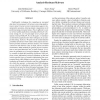121
click to vote
NDSS
2008
IEEE
15 years 7 months ago
2008
IEEE
Fuzz testing is an effective technique for finding security vulnerabilities in software. Traditionally, fuzz testing tools apply random mutations to well-formed inputs of a progr...
117
click to vote
NDSS
2008
IEEE
15 years 7 months ago
2008
IEEE
Traditionally, techniques for computing on encrypted data have been proposed with privacy preserving applications in mind. Several current cryptosystems support a homomorphic oper...
132
Voted
NDSS
2008
IEEE
15 years 7 months ago
2008
IEEE
Protocol reverse engineering has often been a manual process that is considered time-consuming, tedious and error-prone. To address this limitation, a number of solutions have rec...
126
click to vote
NDSS
2008
IEEE
15 years 7 months ago
2008
IEEE
Accurate network measurement through trace collection is critical for advancing network design and for maintaining secure, reliable networks. Unfortunately, the release of network...
NDSS
2008
IEEE
15 years 7 months ago
2008
IEEE
NDSS
2008
IEEE
15 years 7 months ago
2008
IEEE
Although several wide-spread internet applications (e.g., job-referral services, dating services) can benefit from online matchmaking, protocols defined over the past two decade...
103
click to vote
NDSS
2008
IEEE
15 years 7 months ago
2008
IEEE
Automatic signature generation is necessary because there may often be little time between the discovery of a vulnerability, and exploits developed to target the vulnerability. Mu...
128
click to vote
NDSS
2008
IEEE
15 years 7 months ago
2008
IEEE
We study the problem of reliably searching for resources in untrusted peer-to-peer networks, where a significant portion of the participating network nodes may act maliciously to...
103
click to vote
NDSS
2008
IEEE
15 years 7 months ago
2008
IEEE
We present the first empirical study of fast-flux service networks (FFSNs), a newly emerging and still not widelyknown phenomenon in the Internet. FFSNs employ DNS to establish ...





